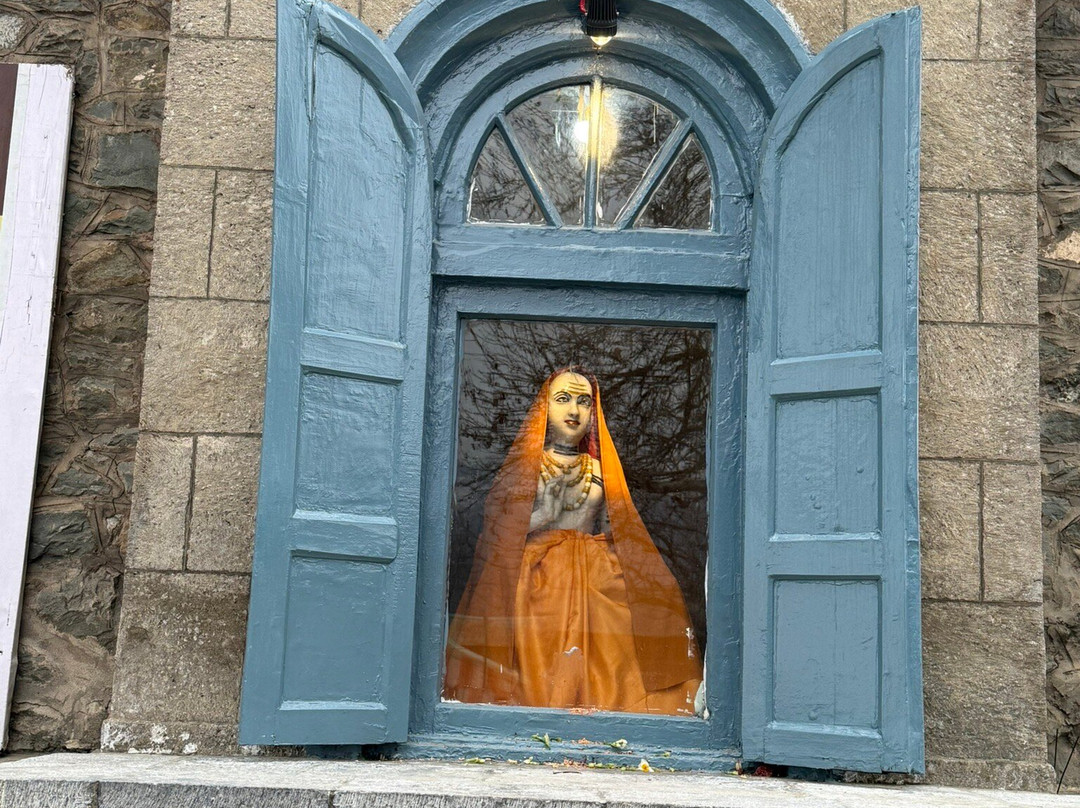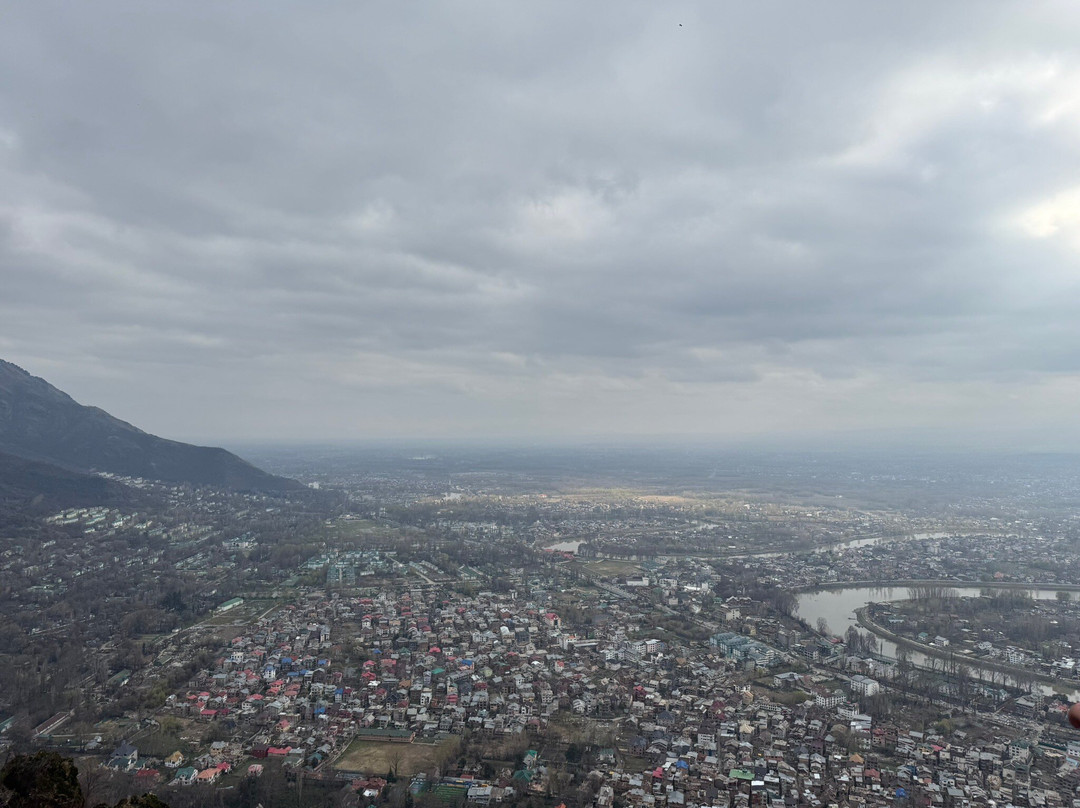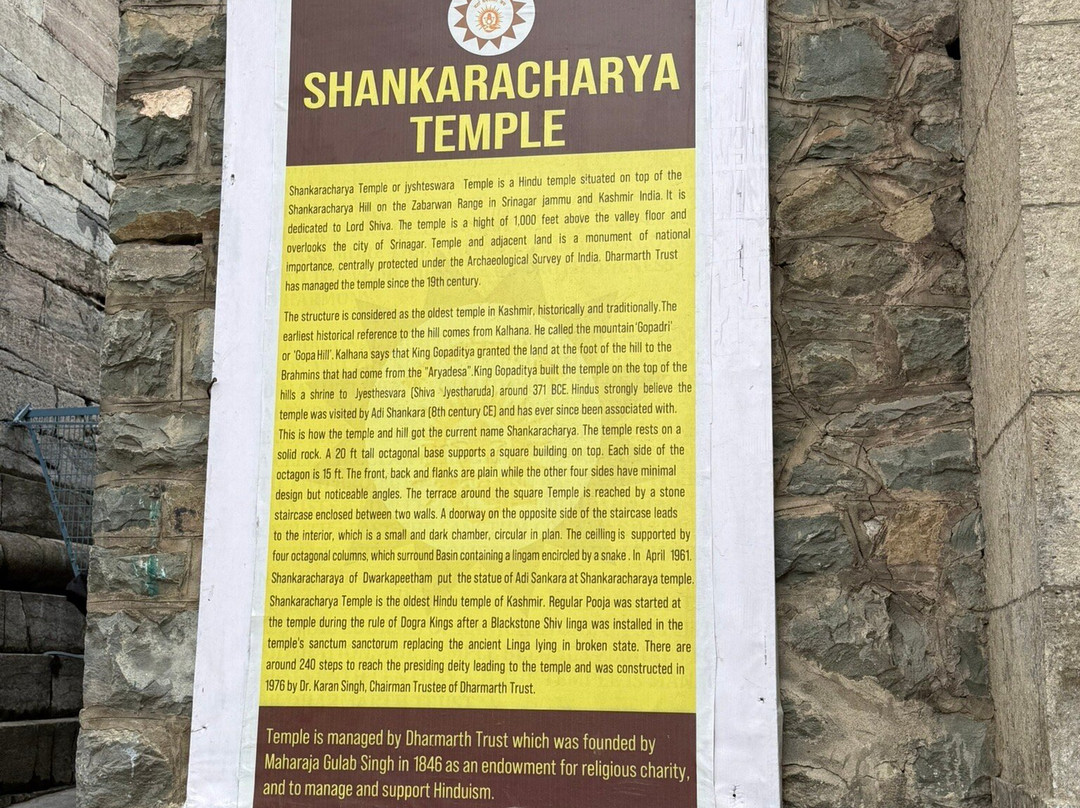的点评
A must visit for historians and Hindus visiting Srinagar
Shankaracharya Hill的点评
点评:A must visit for every Hindu going to Srinagar , The Alchon Hun king, Mihirakula is said to have been the founder of the temple, dedicated to Shiva,a shrine named Mihiresvara in Halada, and a large city called Mihirapura
In 1899 James Fergusson placed the temple construction to the 17th to 18th century. Fergusson disputes claims that structures on the basis of which he makes this claim are from repairs. Stein while agreeing that the superstructures are from a more recent date, places the base and the stairs as much older.Historical figures associated with the monument include Jaloka, one of the sons of Ashoka (Gonandiya), according to the Rajatarangini.
Front profile.
(Graffiti on monuments is commonplace throughout India
Kashmiri Hindus strongly believe the temple was visited by Adi Shankara and has ever since been associated with him; this is how the temple and hill got the name Shankaracharya ,It is here that the literary work Saundarya Lahari was composed by Adi Shankara after accepting the major faith in the region at the time, that of Shakti, and that the union of Shiva and Shakti, as in Shaktism, transpired into the symbolism of the Sri Yantra.
In 1899 James Fergusson placed the temple construction to the 17th to 18th century. Fergusson disputes claims that structures on the basis of which he makes this claim are from repairs. Stein while agreeing that the superstructures are from a more recent date, places the base and the stairs as much older.Historical figures associated with the monument include Jaloka, one of the sons of Ashoka (Gonandiya), according to the Rajatarangini.
Front profile.
(Graffiti on monuments is commonplace throughout India
Kashmiri Hindus strongly believe the temple was visited by Adi Shankara and has ever since been associated with him; this is how the temple and hill got the name Shankaracharya ,It is here that the literary work Saundarya Lahari was composed by Adi Shankara after accepting the major faith in the region at the time, that of Shakti, and that the union of Shiva and Shakti, as in Shaktism, transpired into the symbolism of the Sri Yantra.
翻译:对于前往斯利那加的每一个印度教徒来说,这里都是必游之地。据说,Alchon Hun 国王 Mihirakula 是这座寺庙的创始人,该寺庙供奉湿婆神,在哈拉达有一座名为 Mihiresvara 的神殿,还有一座名为 Mihirapura 的大城市。1899 年,詹姆斯·弗格森 (James Fergusson) 将寺庙的建造时间定为 17 至 18 世纪。弗格森反驳了有关他提出这一说法的依据,即建筑物是修缮而成的。斯坦虽然同意上层建筑的建造时间更近,但认为底座和楼梯的建造时间要早得多。根据 Rajatarangini 的说法,与这座纪念碑有关的历史人物包括 Jaloka,他是阿育王 (Gonandiya) 的儿子之一。
正面轮廓。
(纪念碑上的涂鸦在整个印度都很常见
克什米尔印度教徒坚信阿迪·商羯罗曾到访过这座寺庙,从此与他联系在一起;这就是这座寺庙和山丘得名 Shankaracharya 的原因,正是在这里,阿迪·商羯罗在接受了当时该地区的主要信仰——沙克蒂之后创作了文学作品《桑达里亚·拉哈里》,而沙克蒂主义中的湿婆和沙克蒂的结合,变成了 Sri Yantra 的象征。
正面轮廓。
(纪念碑上的涂鸦在整个印度都很常见
克什米尔印度教徒坚信阿迪·商羯罗曾到访过这座寺庙,从此与他联系在一起;这就是这座寺庙和山丘得名 Shankaracharya 的原因,正是在这里,阿迪·商羯罗在接受了当时该地区的主要信仰——沙克蒂之后创作了文学作品《桑达里亚·拉哈里》,而沙克蒂主义中的湿婆和沙克蒂的结合,变成了 Sri Yantra 的象征。
旅行类型:全家游






此点评仅代表旅行者个人的主观意见,并不代表TripAdvisor以及其合作方的意见。
关于我们
|新闻动态
|商务合作
|会员中心
|业主中心
|常见问题
|意见反馈
|联系我们
|营业执照
© 2025 Tripadvisor 版权所有。
使用条款 |隐私政策 |网站工作原理
部分照片由 VFM Leonardo 提供。
* Tripadvisor不是旅行社,也不是旅游预订服务代理商。我们提供免费、客观、公正的旅游资讯服务。 (显示更多)
TripAdvisor LLC 既不是预订代理商,也不是旅游运营商,不会向网站用户收取任何服务费。 按照规定,在 Tripadvisor 发布机票价格、游览和旅行套餐的合作伙伴(航空公司、旅行提供商及预订代理商),其标价须包含所有费用和附加费用。 例如, 机场出入境税费、消费税与其他服务费、手续费、杂费及附加费用。 当您向我们的某个合作伙伴进行预订时,请务必查阅他们的网站以了解当地行政部门要求的所有适用费用的具体情况。 除非另有说明,机票价格通常指的是一个人的价格(以人民币计)。
为方便起见,TripAdvisor LLC 根据从我们的预订合作伙伴获取的空房率计算每个酒店的均价。 对于游览和景点来说,所显示价格通常是每位成人的最低可用价格。 对于列出的任何旅行套餐或优惠,TripAdvisor LLC 无法保证任何特定的费率或价格。 此外,酒店均价每晚会更新,并以您的首选币种表示(使用现行汇率)。 由于这些已换算的价格是预估价格,因此,有关具体金额和币种请与预订网站进行核实。
此外,TripAdvisor LLC 无法保证我们网站上宣传的价格随时有效。 标价可能需要预订一定天数才能生效,或有不可用日期、使用条件或限制。
TripAdvisor公司对外部网站的内容一概不负责。优惠价格中不含税和其他费用。
ICP证:沪B2-20200433
沪ICP备20013175号
 沪公网安备31010502005427号
沪公网安备31010502005427号鹰程信息技术(上海)有限公司
货币/国家及地区
¥CNY
中国

